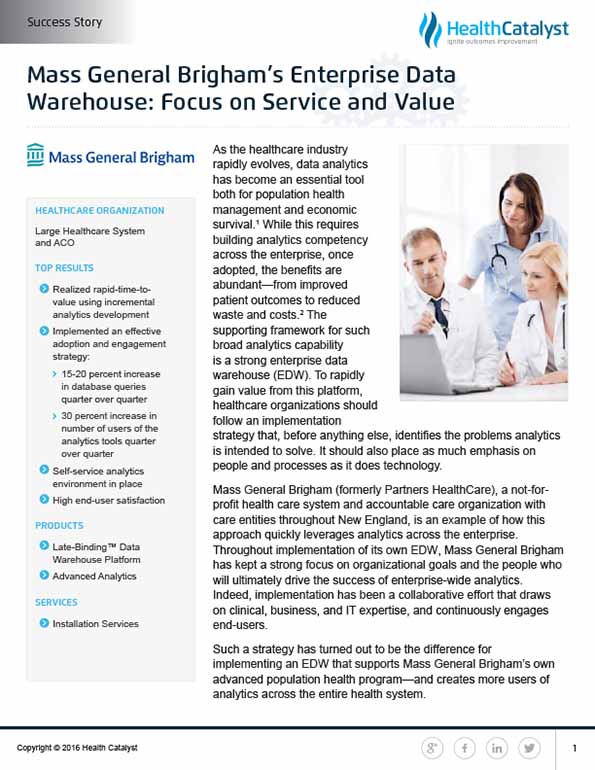As the healthcare industry evolves, implementing an enterprise data warehouse is crucial for population health management. Read how Mass General Brigham (formerly Partners HealthCare) implemented a data warehouse and quickly leveraged analytics across the enterprise, achieving value with high end-user engagement and satisfaction.
As the healthcare industry rapidly evolves, data analytics has become an essential tool both for population health management and economic survival.1 While this requires building analytics competency across the enterprise, once adopted, the benefits are abundant—from improved patient outcomes to reduced waste and costs.2 The supporting framework for such broad analytics capability is a strong enterprise data warehouse (EDW). To rapidly gain value from this platform, healthcare organizations should follow an implementation strategy that, before anything else, identifies the problems analytics is intended to solve. It should also place as much emphasis on people and processes as it does technology.
Mass General Brigham (formerly Partners HealthCare), a not-for-profit health care system and accountable care organization with care entities throughout New England, is an example of how this approach quickly leverages analytics across the enterprise. Throughout implementation of its own EDW, Mass General Brigham has kept a strong focus on organizational goals and the people who will ultimately drive the success of enterprise-wide analytics. Indeed, implementation has been a collaborative effort that draws on clinical, business, and IT expertise, and continuously engages end-users.
Such a strategy has turned out to be the difference for implementing an EDW that supports Mass General Brigham’s own advanced population health program—and creates more users of analytics across the entire health system.
Mass General Brigham knew that it was critical not to focus solely on the technology aspect of an EDW implementation and lose sight of the people and processes the solution was meant to serve. However, Mass General Brigham did have certain technology requirements. The health system needed an EDW that was scalable, sustainable, and easy to support. It also wanted a model that out of the gate provided simple design rules that limits debates about architecture and instead creates consistency in solution design.
These features would help Mass General Brigham overcome a common healthcare industry challenge: While automation of clinical and operational processes creates more data for the health system, it is generated within a very fragmented data environment. Stakeholders have different and often competing priorities in such a landscape, yet there are scenarios that call for broad access to data—from demonstrating quality and safety, to making strategic decisions about patient care redesign initiatives. A consistently designed EDW would help enable centralized data management within this decentralized analytics model.
Most importantly, it would serve as a shared, common platform that maximizes information by getting it in the right hands in a timely manner. This is the fundamental feature of “self-service” analytics where users from across the enterprise can access and mine data without assistance from IT—which in turn, more quickly produces business and clinical value.
To enable and support the quick advancement of analytic capabilities and competencies, Mass General Brigham adopted a thoughtful mix of project management, user engagement, and technology processes for its EDW initiative. This is reflected in five key principles followed throughout implementation:
Incremental deployment. Adopting the Agile implementation methodology3, Mass General Brigham deployed an EDW in a phased, incremental fashion with each deliverable producing value.
Service orientation. Mass General Brigham placed great importance on the needs of end-users and the analytic community, knowing that data management and delivery is a “high touch” service where a typical IT support model doesn’t work.
Technical skills with business acumen. Team collaboration is key for deploying highly valuable solutions. Mass General Brigham took care to create an EDW team that was well suited and comfortable engaging and interacting with their peers in business and clinical areas.
Prototyping. Mass General Brigham demonstrated that iterating through demos and mock-ups is more efficient than simply asking for requirements and assuming they are actually what the business needs.
Flexibility. Given the diversity of the analytic community and the analytic needs at Mass General Brigham, the EDW team leveraged a suite of solutions and approaches to best meet the needs. There isn’t one solution or approach that meets every need, and some tactics work better with some customers than others. Standards are important, and there are times not to deviate—but not at the cost of better outcomes.
For an EDW that would harness and merge data for decision makers across the enterprise, Mass General Brigham deployed a late-binding enterprise data warehouse from Health Catalyst, creating an EDW analytics foundation supported by four cornerstones:
Repository of clinical, operational, financial and claims data, with clear design rules and expectations for data architects.
Tools for end users to manage and query the data. To help users learn the tools more quickly, Mass General Brigham provided training and feedback on the tools to provide information for clinical and business decisions.
Support services to assist users in their understanding of the data, as well as use of the tools. Outreach and engagement included executive road shows, educational programs, user groups and a community forum experiment. An end-user/stakeholder survey was also developed and administered to measure adoption and satisfaction.
Governance to provide structure for program-level decision-making and prioritization. This laid the groundwork for adoption and engagement from executives to frontline staff. It also created an environment that increased collaboration across business entities and promoted continuous learning and process improvements. A key component was the formation of an advisory committee to act as a sounding board and promote stakeholder engagement.
By all measures, Mass General Brigham executed an EDW and analytics approach that will serve as the foundation to support the organization’s mission going forward. It achieved its original commitments to the governing board for the initiative, including goals for people, processes and technology, within its original time frame and budget. The result is a solid infrastructure in place to support informed and major improvements in patient care.
Realized rapid-time-to-value using incremental analytics development. By adopting the Agile methodology, Mass General Brigham has an EDW and analytics that have quickly delivered value.
Implemented an effective adoption and engagement strategy. As a result of an outreach program that included executive roadshows, education sessions and user groups, Mass General Brigham continues to support self-service analytics. Early results to date show a:
Self-service analytics environment in place. Rollout to additional departments is continuous and enabled by self-support groups.
High end-user satisfaction. Based on the baseline results (shown below) of the internal survey to measure adoption and satisfaction, Mass General Brigham has achieved a high degree of success with its initial EDW rollout. Improving and building its service offering remains an important focus of the team.
“We have created a great environment for analytics. Now it is time to move on to raising awareness, engaging end users and using the data to improve our clinical and business outcomes.”
- Cynthia Bero, IS Director
Further success will depend on continuing to enhance existing analytic assets, and deliver new capabilities. Beyond that will be the increasing focus on analyst support and training. It will be important to ensure constituents are aware of what is available, understand the content, be positioned to leverage tools to analyze results, and, most importantly, interpret results that will ultimately drive decision making.
Mass General Brigham continues to drive awareness and engagement in support of developing a culture of analytics. The ultimate success metrics: are users getting access to the data they need, and are they able to use it to effectively drive improvements?




